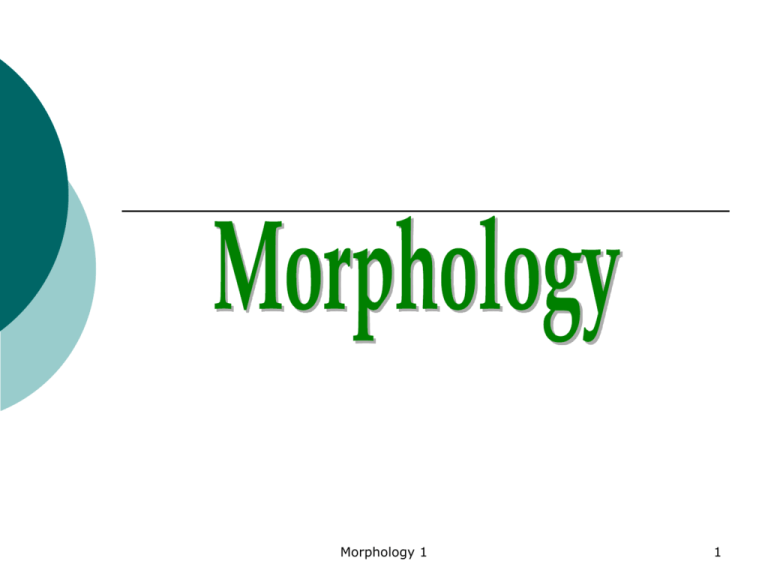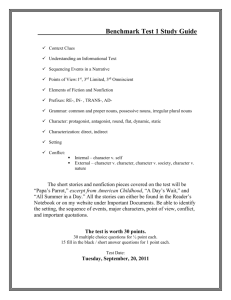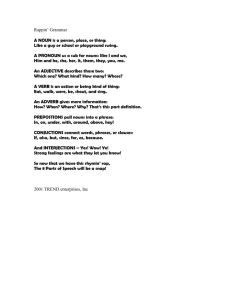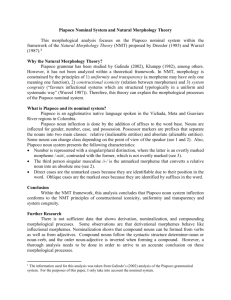nouns - Nechodimnaprednasky.sk
advertisement

Morphology 1 1 NOUNS Morphology 1 2 A noun tells us what someone or something is called. a noun can be: the name of a person (John) a job title ( a doctor) the name of a thing ( radio) the name of a place ( London) the name of a quality (courage) the name of an action (laughter/laughing). Nouns are the names we give to people, things, places etc. in order to identify them Morphology 1 3 Nouns are designators used to refer to objects (referents) of extralinguistic reality. Morphology 1 4 morphological point of view: nouns are characterized by grammatical categories (sometimes called secondary grammatical categories) which are actually certain generalizations which are made about the properties that nouns exhibit. Morphology 1 5 English nouns exhibit categories of countability number determination gender case Morphology 1 6 PROPER NOUNS CONCRETE COUNT ABSTRACT COMMON CONCRETE UNCOUNT/ MASS ABSTRACT Morphology 1 7 NOUN CATEGORIES: GENDER Morphology 1 8 the most controversial of all noun categories Introduction of some changes in the existing system of gender categories Morphology 1 9 Slovak nouns as masculine, feminine or neuter. Morphology 1 10 In English, nouns are not divided into gender groups equivalent to Slovak ones. Gender plays only a minor role in the system of English grammar – the few gender distinctions that are made are manifested in the use of pronouns and in reference to nouns. Morphology 1 11 personal Animate Nouns Nonpersonal Inanimate -Masculine -Feminine -Dual -Common -Collective uncle aunt doctor baby family who - he who - she who – he/she who – he/she/it (which) which-it (who/they) -Masculine higher animal bull which – it (who – he) cow which – it (who – she) horse ship ant which – it (who – he/she) which - it which - it -Feminine higer animal -Common higer animal -Higer organism -Lower animal - Inanimate – box Morphology 1 which -it 12 1.Personal masculine/feminine nouns form pairs: a/Without marked morphological differentiation (i.e. different lexical units): man/woman,husband/wife, sir/madam b/ with marked morphological differentiation (i.e. derivational relationship, masculine is unmarked, suffixes – ess, ine, ette) derivational suffixes – emperor/emperess, hero/heroine compound nouns – man teacher/woman teacher Morphology 1 13 In some exceptions, feminine nouns may be unmarked – widow/widower Some nouns do not have a counterpart of the opposite gender (dandy) Many animal names follow the above classification: Stallion /mare, he-goat/she-goat Morphology 1 14 2. dual (superordinate) term (parent for father/mother) increasing use of dual nouns (author) with which the gender is indicated only from the pronominal reference. The author says she is working on another novel. The reasons for this are claimed to be the elimination of the existing asymmetries in language (e.g. unmarked noun = masculine, marked = feminine)in an effort to fight stereotypes and bias, such as sexism, or the fact that some derived nouns may have acquired unfavorable connotations over time. Morphology 1 15 Sometimes explicit gender reference with dual nouns is needed (nurse – male nurse) Morphology 1 16 3.Common and collective nouns have both personal and nonpersonal reference, though not in all contexts. Morphology 1 17 In the former case, familiarity or emotional involveness – positive emotional attitude - is decisive (child = she or he not it). Morphology 1 18 In the latter, the opposition of individuality (personal reference, plural concord) or collectivity (non-personal reference = singular concord) is at play. The jury have (= they)/ has (=it)returned the verdict of guilty. Morphology 1 19 4. Higher animal (i.e. domestic, farming animals, pets ) nouns follow : morphologically unmarked (buck/doe) marked masculine/feminine distinction. (tiger/tigress ) In case the gender distinction is irrelevant, one term is used for both sexes (lion for lion/lioness). Morphology 1 20 5.Common higher animal nouns include those of which no distinction is made We went to see the Peterson´s horse which they bought only recently. Morphology 1 21 6. Higher organisms are represented by a/ names of countries (geographical units – inanimate, political/social/economic units – personal feminine, in sports – personal collective, in all cases non-personal relative pronoun used) Morphology 1 22 7. Lower (less familiar) animals as well as inanimate nouns have identical nonpersonal reference. Occasionaly, a gender distinction may be made by means of compounding. (hegoat/she –goat) Morphology 1 23 A closely related problem to the category of gender is the claim that English is a sexist language because it reinforces existing societal gender stereotypes and is used as a tool of verbal abuse, which may easily lead to physical abuse. Morphology 1 24 Among the very often quoted examples belong: - Professor is male, nurse female - The word man widely used in compound nouns (postman) exclude females - there is no gender-neutral (non-sexist) 3rd person pronoun , though many suggestions have been made to fill the gap, for example, the proposed words include : co, et, han, heris, herm, hesh, jhe, na person, she/he, (s)he, she or he, sher, shim etc. - female nouns ending in suffixes –ess, -ette are formed from unmarked male nouns, - many female nouns have acquired demeaning undertones (lady) Morphology 1 25 The proponents of non-sexist usage suggest the following solutions: replace the word man when it is not meant to include males only with human – humankind, use male/female only when referring to sex distinctions in compounds, use woman only to clarify the meaning when reffering to man as a species, use ancestors, forebears, human society eliminate the use of discriminatory derivational suffixes – ess use one instead of exclusive he Anyone can present their ideas in public. instead of Anyone can present his/her ideas in public. Morphology 1 26 CASE Morphology 1 27 the position of the category in English is quite specific, as syntactical relations are realized analytically by word order and prepositions rather than by noun inflections which have been lost in the course of the historical development of English. Morphology 1 28 As a result, the inventory of ModE inflectional case endings is limited to the ´s genitive the sole survivor from the OE synthetic declensional system of nouns. Morphology 1 29 Also called possesive case (or Saxon genitive), ´s genitive forms a two-member category with common case, in which the latter is the unmarked member. Morphology 1 30 As the functions of the ´s genitive are by no means exhausted by that of denoting possession, sometimes the term adnominal case is preferred. Morphology 1 31 Besides adnominal inflectional case, of-genitive (a postmodifying of phrase) is also used to signal case distinction in English. Morphology 1 32 As to the form of the ´s genitive, it is homophonic with the regular plural ending –s and pronounced s, z , iz depending on the preceding sound Morphology 1 33 In writing, on singular nouns it is marked by the apostrophe and the suffix (a girl’s dream), on regular plural nouns only by the apostrophe (zero genitive , students´ essays) on irregular plurals, it is marked exactly as on regular singular nouns (children’s toys) Morphology 1 34 Some nouns ending in s, sometimes admit only the apostrophe while retaining ziz or iz pronunciation. Charles´ visits abroad, Keats´ books Morphology 1 35 Mary and Jane´s friends Mary´s and Jane´s friends Morphology 1 36 Mary and Jane´s friends (the friends they share) Mary´s and Jane´s friends (Mary´s friends and Jane´s friends, not shared) Morphology 1 37 ´s genitive has several features in common with adjective-forming suffixes and thus it is possible to view it as on of them, not as a case ending of the noun. It always precedes the modified head noun, and it can be attached to the whole phrase group genitive if the semantic feature applies to both NPs together. If the feature applies to the NPs individually, the -´s morpheme is used with each Morphology 1 38 Double genitive: combines adnominal and of-genitive typical construction – a book of Peter´s = one of Peter´s books. Other possible determiners are demonstratives, and wh- determiners, but not the. That crazy idea of Peter’s drives me mad. – criticism Peter’s crazy idea. – used in preference +The crazy idea of Peter’s.+ Morphology 1 39 In some cases, ´s genitives and postmodifying of-phrases are used indiscriminately The ship´s name, the name of the ship With ´s genitive being more compact and economical. Morphology 1 40 In most cases though, the two genitives have a separate range of uses: Morphology 1 41 a/The ´s genitive case (adnominal case) is used only with a subclass of nouns (mainly those denoting humans) and with the other nouns the same meaning is expressed by and of – genitive. Morphology 1 42 b/ register (all registers prefer – of genitives, ´s genitives are most frequent in news writing) Morphology 1 43 c/ type of dependent noun ´s genitives are used primarily with animate nouns – personal names and proper nouns, higher animal nouns (lion´s den), collective nouns (the jury´s decision) Some special types of inanimate nouns, esp. those admitting personification (geographical names – Europe´s turbulent times), locative nouns (university´s staff), temporal nouns (this year´s unemployment rate) or set expressions ( a dollar´s worth trinkets) Morphology 1 44 Of genitives are used primarily with inanimate concrete nouns (the door of the bus) Abstract impersonal nouns ( a feeling of sadness) Morphology 1 45 d/semantic relation between the head and the dependent phrase: ´s genitive is commonly used as possessive genitive (my family´s savings),subjective genitive (my mother-in-law´s arrival), objective genitive (the dean´s election), genitive of origin (senator´s fault), descriptive genitive (a winter´s tale), a genitive of measure (a few minute´s walk) Morphology 1 46









